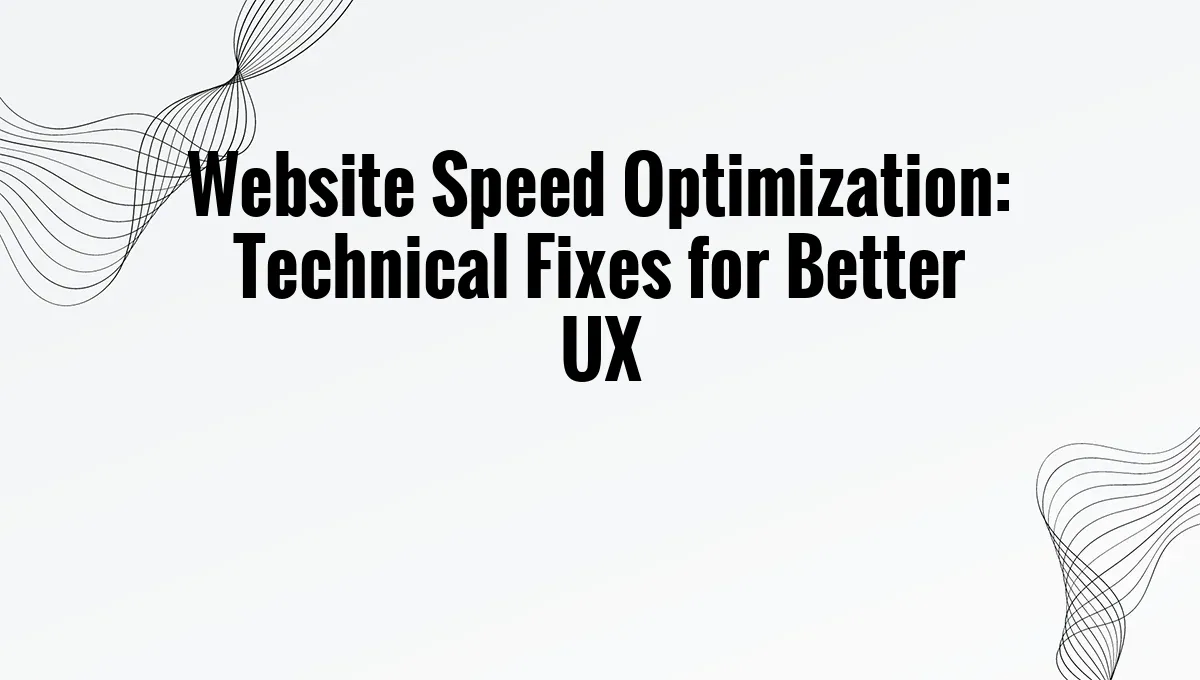Website Speed Optimization: Technical Fixes for better UX
in today’s digital landscape, speed is not just important; it’s essential. A delay of even a second can cause potential customers to abandon your site. Think about it: if your website is slow to load, you’re not just losing time; you’re losing prospects, sales, and ultimately, market share.
At Cham Agency, we understand that website speed optimization is not merely a technical fix; it’s a strategic initiative that can dramatically enhance user experience (UX), drive traffic, and boost conversions. Let’s dive deep into actionable strategies to get your site performing at its best.
Why Speed Matters
Before getting into the nitty-gritty of speed optimization, let’s talk numbers. According to Google, 53% of mobile users will abandon a site that takes longer than three seconds to load. Amazon calculated that every 100ms of latency cost them 1% in sales. Those are not just isolated figures; they represent the critical nature of speed in our online world.
A fast website isn’t just favorable for your visitors-it’s a ranking factor for search engines. If you want to improve your SEO and stay ahead of competitors, speed optimization should be at the forefront of your strategy.
Technical Fixes to Boost Your Website’s Speed
Here are proven strategies that deliver massive results-not just in theory, but in practice.
1. Optimize Images
Images are a double-edged sword; while they enhance the visual appeal of your site, they can also bloat loading times. To combat this:
- Compress Images: Use tools like TinyPNG or ImageOptim to reduce file sizes without sacrificing quality. An image that’s 1MB can typically be reduced to a fraction of that wiht little visible difference.
- Use the Right Formats: JPEGs work for photographs, while PNGs are better for images with transparency.For vector graphics,SVGs are ideal.
- Lazy Loading: Implement lazy loading techniques to ensure that images only load when they enter the viewport. This way, users aren’t waiting on all images to load before they can interact with your site.
2.Leverage Browser Caching
Caching stores copies of files so your site doesn’t have to load everything from scratch every time a visitor arrives. It’s like having a shortcut; rather than pulling from the original source each time, your server can deliver files more quickly.
- Set Expiration Dates: Use caching plugins like WP super Cache for WordPress sites to set expiration dates on various types of content. This means users will load static files from their browser cache rather than downloading the same data repeatedly.
3. Minimize HTTP Requests
Every element on your page (images, JavaScript files, stylesheets) requires an HTTP request. Fewer requests mean a faster loading time.
- Combine Files: Where possible,combine CSS/JavaScript files to reduce the total number of requests made by the browser.
- Use CSS Sprites: For icon sets or multiple images, combine them into a single image and use CSS to display only the visible parts.It’s a trick that saves requests and bandwidth.
4. Use a Content Delivery Network (CDN)
A CDN caches content across multiple geographical locations, making it easier and faster for users to access your website irrespective of their location.
- Benefits: A CDN reduces latency and speeds up delivery times, especially for users on the other side of the globe from your servers. This is critical in reducing load times and improving the overall user experience.
5. Optimize Your Code
Your site is only as fast as its underlying code.Clean, optimized code translates to better performance.
- Minification: Remove unnecessary characters from your HTML, CSS, and JavaScript files. Tools like UglifyJS for JavaScript and CSSNano for CSS can greatly reduce file sizes.
- Asynchronous Loading: Consider loading JavaScript files asynchronously, allowing the page to render without waiting for the scripts to load first.
Tracking Your Progress
After implementing these strategies, you need to track and analyze your progress. Use tools like Google PageSpeed Insights, gtmetrix, or Pingdom to monitor your site’s performance. Set benchmarks before making changes and measure improvements afterwards to understand what’s working.
The Mindset Shift: speed Equals Success
It’s vital to realize that speed optimization is more than just a checklist; it’s a continuous process. A fast website is indicative of a brand that values its customers. It shows that you care about providing an excellent user experience, ultimately winning their trust and loyalty.
Real-World Example
Take the case of E-commerce Giant X. After a complete overhaul focused on speed, which included optimizing images and implementing a CDN, they saw a 40% increase in conversion rates and a 25% decrease in bounce rates within a few months. Their instance underlines how technical fixes can led directly to tangible business success.
Conclusion: Speed Is Non-Negotiable
In the relentless race of online business, every millisecond counts. Speed optimization isn’t a just ’nice-to-have’; it’s a crucial investment in your online brand. Every second saved can translate into real revenue and customer satisfaction.
At Cham Agency, we’re not just about designing websites; we’re about crafting experiences. By implementing these technical fixes, you can enhance your website’s performance and, consequently, your brand’s growth trajectory.
Ready to speed up? Let’s talk about how we can definitely help your brand put its best foot forward in the digital world.
By embracing these website speed optimization techniques, you can take a strategic leap toward providing exceptional user experiences and achieving business success. Remember, fast sites are the new standard-let yours lead the charge!





